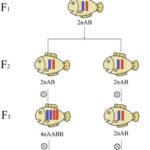
Researchers are exploring ways to optimize the survival and growth of Pacific white shrimp (Litopenaeus vannamei), key factors that affect farm productivity.
A recent study published in the journal Aquaculture and Fisheries, conducted by scientists from the Fisheries Research Institute of Fujian, Xiamen University, Jimei University, and the Fujian Fishery Resources Monitoring Center, investigated the potential of hybridization as a tool to improve the vital traits of vannamei shrimp. Hybridization leverages “hybrid vigor,” a phenomenon where offspring from different genetic lines exhibit superior performance compared to their parents.
The Power of Genetic Improvement
To address these challenges and ensure a sustainable supply of high-quality aquatic products, genetic improvement strategies are essential. Hybridization, a technique that involves crossing individuals from distinct genetic origins, has emerged as a promising approach. It harnesses the phenomenon of heterosis, where offspring often display superior traits compared to their parents.
Hybridization: A Powerful Genetic Tool
Hybridization, the mating of individuals from different genetic backgrounds, has proven to be a particularly effective genetic improvement strategy. It often results in offspring with superior traits, a phenomenon known as heterosis.
The Research
The research team conducted a meticulous crossbreeding experiment using a complete 4×4 diallel cross design. This involved four carefully selected white shrimp strains (strains 5, 8, 9, and 10). The primary goal was to identify pairings that exhibited exceptional hybrid vigor.
Unlocking Superior Performance
The results were truly impressive! Crosses between strains 8 and 9 emerged as clear favorites. These hybrid offspring showed a remarkable 16.52% increase in survival and an astonishing 18.93% increase in growth compared to their average parents (mid-parent heterosis or H89).
Beyond Averages: Reciprocal Advantages
The research team observed a fascinating trend: most reciprocal hybrids, regardless of parental orientation, showed higher survival rates than their inbred parental strains. This suggests a broader applicability of this technique beyond specific pairings.
Growth Increase with Age
The study revealed another exciting discovery. The positive impact of hybrid vigor on weight gain intensified with age. This translates to significant benefits for shrimp farmers, as their harvest will potentially yield larger, healthier shrimp over time.
Stay Always Informed
Join our communities to instantly receive the most important news, reports, and analysis from the aquaculture industry.
A Brighter Future for the Shrimp Industry
These findings paint a promising picture for the future of white shrimp aquaculture. Hybridization offers a powerful tool to improve both survival and growth rates, ultimately leading to higher farm productivity and economic gains. This study not only validates the effectiveness of hybridization but also provides valuable genetic resources for future shrimp breeding programs.
The findings of this study have significant implications for the shrimp industry:
- Enhanced Breeding Programs: Hybrids identified with superior traits can be used to develop more efficient and productive breeding programs.
- Improved Production: Hybridization offers the potential to increase yield and quality in white shrimp production.
- Consideration of Maternal Effects: Future breeding programs should account for maternal effects to optimize offspring performance.
- Targeted Breeding: By selecting strains with desirable combining abilities, breeders can focus on developing hybrids with specific traits of interest.
Conclusion
Hybridization holds significant potential for improving white shrimp production. By carefully selecting parental strains and utilizing advanced breeding techniques, researchers can develop shrimp lines that are more resilient, productive, and profitable.
The study, conducted to investigate the potential of hybridization to improve white shrimp (Litopenaeus vannamei) production, yielded several significant findings:
- Heterosis and Heritability: Hybridization revealed heterosis and heritability of desirable traits in white shrimp, laying the groundwork for future selective breeding programs.
- Improved Growth and Survival: Several reciprocal hybrids demonstrated significant improvements in weight gain and survival rates compared to inbred groups, suggesting their potential for enhancing shrimp production.
- Maternal Effects: The study observed maternal effects influencing offspring phenotype, highlighting the importance of considering maternal genotypes in breeding programs.
- Hybrid Vigor: Heterosis, or hybrid vigor, was observed in many hybrid combinations, indicating the benefits of crossing genetically diverse parents.
- Combining Ability: Certain strains exhibited higher general combining ability (GCA) for survival or growth, suggesting their potential to produce superior hybrid offspring.
As the aquaculture industry continues to grow, genetic improvement strategies like hybridization will play a vital role in ensuring a sustainable and abundant supply of aquatic resources.
The study was funded by the Seed Industry Innovation and Industrialization Project in Fujian Province.
Contact
Weiwei You
College of Ocean and Earth Sciences, Xiamen University
Xiamen, 361102, China
Email: wwyou@xmu.edu.cn
Reference (open access)
Yang, Z., Zhang, Z., Wang, G., Huang, Z., & You, W. (2024). Exploiting hybrid vigor to enhance survival and growth for whiteleg shrimp (Litopenaeus vannamei): A complete diallel cross experiment. Aquaculture and Fisheries. https://doi.org/10.1016/j.aaf.2024.04.004
Editor at the digital magazine AquaHoy. He holds a degree in Aquaculture Biology from the National University of Santa (UNS) and a Master’s degree in Science and Innovation Management from the Polytechnic University of Valencia, with postgraduate diplomas in Business Innovation and Innovation Management. He possesses extensive experience in the aquaculture and fisheries sector, having led the Fisheries Innovation Unit of the National Program for Innovation in Fisheries and Aquaculture (PNIPA). He has served as a senior consultant in technology watch, an innovation project formulator and advisor, and a lecturer at UNS. He is a member of the Peruvian College of Biologists and was recognized by the World Aquaculture Society (WAS) in 2016 for his contribution to aquaculture.




